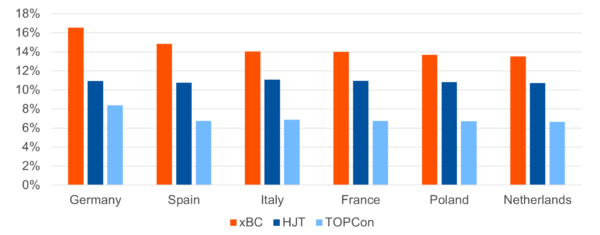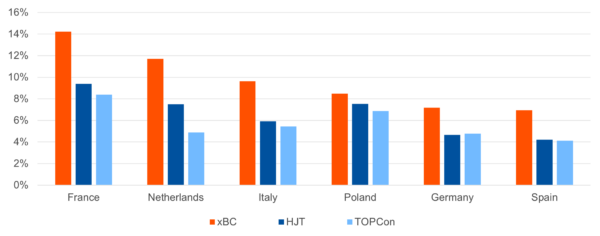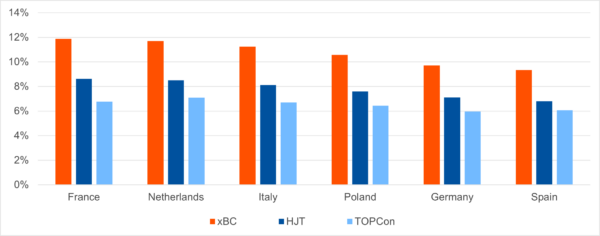A new white paper from research and consulting firm Exawatt examines and contrasts key module parameters across various technologies to assess the potential value these technologies may offer for residential and commercial applications. The white paper, authored by Molly Morgan and Alex Barrows of Exawatt, draws on analyses from the company’s Solar Technology and Cost Service.
The paper reveals that, in the modelling performed, back contact (xBC), heterojunction (HJT), and tunnel oxide passivated contact (TOPCon) technologies may exhibit meaningful improvements in lifetime energy generation compared to mono passivated emitter rear contact (PERC) technologies. Through detailed modelling exercises, the document evaluates how xBC, HJT, and TOPCon contribute to increased clean energy generation and potential financial savings depending on specific system parameters.
In both residential and commercial system modelling scenarios, the authors found that xBC stands out as the top performer, showing an average increase of 16.0% over mono PERC, while HJT and TOPCon offer generation gains of 11.4% and 8.2%, respectively.

Furthermore, the white paper delves into the profitability of residential and commercial installations through assessments of payback time and levelized cost of electricity (LCOE). Despite their premium pricing, xBC, HJT, and TOPCon technologies demonstrate enhanced profitability in both modelling scenarios in comparison to the previously mainstream mono PERC. Among these technologies, xBC emerges as the frontrunner, boasting an average 9.7% shorter payback time and 10.7% lower LCOE across all modelled locations.


While small cost reductions may still be achieved in the current PV industry, the white paper outlines that these are relatively minor in comparison to the potential efficiency gains offered by advanced technologies. High module efficiency is key to driving down system cost-per-watt, payback time, and LCOE, since it can drive down the per-watt costs of many key non-module costs such as labor and mounting.
The white paper underscores the importance for distributors, installers, and system owners to grasp the value proposition of high-performance technologies for informed decision-making on which technology has the greatest value for a specific application.
The authors conclude that as the industry continues to prioritize performance improvements over cost reductions, embracing high-performance PV technologies can pave the way for enhanced efficiency, cost savings, and sustainable energy solutions.
The views and opinions expressed in this article are the author’s own, and do not necessarily reflect those held by pv magazine.
This content is protected by copyright and may not be reused. If you want to cooperate with us and would like to reuse some of our content, please contact: editors@pv-magazine.com.








By submitting this form you agree to pv magazine using your data for the purposes of publishing your comment.
Your personal data will only be disclosed or otherwise transmitted to third parties for the purposes of spam filtering or if this is necessary for technical maintenance of the website. Any other transfer to third parties will not take place unless this is justified on the basis of applicable data protection regulations or if pv magazine is legally obliged to do so.
You may revoke this consent at any time with effect for the future, in which case your personal data will be deleted immediately. Otherwise, your data will be deleted if pv magazine has processed your request or the purpose of data storage is fulfilled.
Further information on data privacy can be found in our Data Protection Policy.